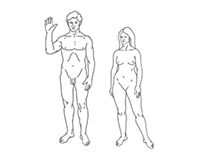Thin-slicing is a term used in psychology and philosophy to describe the ability to find patterns in events based only on ‘thin slices,’ or narrow windows, of experience. The term seems to have been coined in 1992 by Nalini Ambady and Robert Rosenthal in a paper in the ‘Psychological Bulletin.’ Many different studies have shown indication that brief observations can be used to assess outcomes, at levels higher than expected by chance. Once comparing these observations of less than five minutes, to greater than five minutes the data showed no significant change, thus implying that observations made within the first few minutes were unchanging.
One of the first series conducted by James Bugental and his colleagues showed that parents expectancies, identified from brief clips of their tone, are related to their children’s behavior process. The tone of a mother with a normal child and the tone of a mother with behavior problems differed significantly. These conceptions provide an underlying basis that there actually is an ability to judge from brief observations. Research in classrooms has shown that judges can distinguish biased teachers from unbiased teachers along with ‘differential teacher expectancies’ simply from brief clips of teachers’ behaviors. Likewise, research in the courtroom has shown that brief experts of judges’ instructors to jurors in trials, raters could predict the judge’s expectations for the trial.
The term thin-slicing means making very quick decisions with minimal amounts of information. Thinking has always been described as a conscious effort. Henri Cartier-Bresson called thinking a ‘decisive moment’ of consciousness, but in reality thin-slicing is an unconscious behavior. Thin-slicing also has a key affect in biological and sociocultural effects. In one of Nalini Ambady’s experiments, she reminded the female Asian students about their gender or their ethnicity prior to taking a math test. There are many prevailing social stereotypes that suggest women are not good at math and Asians are good at math. Her study showed that subtly cuing students’ gender or ethnic identities affects their performance. The individuals whose ethnicity was cued scored higher than the students whose gender was cued.
One of the most influential books on thin-slicing is ‘Blink’ written by Malcolm Gladwell. In this book, the author goes through and describes interesting examples and research which exploit the idea of thin-slicing. Gladwell describes how a museum purchases a Sculpture brought to the J. Paul Getty Museum in California. Immediately, art experts looked through the sculpture and decided there was something wrong with it, a gut feeling which exhibited all the wrong signs. Yet under thorough investigation the sculpture was deemed real because of no solid evidence against the now known fake. After some given time, the statue was described to be a fake due to simple flaws found within the structures. The art sculptures were able to immediately analyze the situation and realize the fallibly of sculptural. Another example is explained through relationships. John Gottman, a well-known Marital expert, describes how within an hour of observing a couple, he can gather with 95% accuracy if the couple will be together within 15 years. His accuracy goes down to 90% if he observes the couples for more than 2 hours, supporting the phenomenon of thin-slicing.
Dr. Alberchsten and Dr. Meissner of the University of Texas at El Paso conducted two separate studies of processing style (intuitive vs. deliberative processing) in a deception detection task. In the first experiment, a thin-slicing manipulation was used to show that intuitive processing can lead to more accurate judgments of deception when compared with traditional forms of processing. In the second experiment, participants who engaged in a second task performed more accurately in a deception task than participants who were asked to provide a verbal rationale for each decision. The results converged suggest that intuitive processing can significantly improve deception detection performances.
An individual’s mood and judgments have been known to cause and/or distort cognitive abilities. Studies pertaining to judgments made during these time frames, aids the theory that emotions cloud rational concision thoughts. The three most influential studies were conducted by Nalini Ambady at the Harvard University, Department of Psychology. In the first study, induced sadness led to reduced accuracy in judgments of teacher effectiveness from brief samples of nonverbal behavior. In the second study, sad participants showed reduced accuracy in judging relationship type from thin-slices as well as diminished judgmental efficiency. Study 3 showed the possibility that sadness impairs accuracy by promoting a more deliberative information-processing style. All of these studies have the basic principle that emotions do in fact affect judgement as seen through affects on thin-slicing.
‘Dr. Phil,’ the television program is an example of thin-slicing. Dr. Phil’s thin-slicing ability of cutting through ‘bull’ and getting through to the main action of therapy has led many people to question the ability. Many people agree though that Dr. Phil’s method of thin-slicing is detrimental to people’s destructive behaviors. Many other uses of thin-slicing are implied and seen throughout the media such as firemen making split-second decisions, or cops knowing something is wrong by simply a gut feeling. All these imply and show that thin-slicing actually occurs and is a fact of life that actually occurs within everyone. Individuals also believe that the effects of the phenomenon known as déjà vu happen within the same time frame of thin-slicing and might also have a direct correlation.
The Daily Omnivore
Everything is Interesting



Leave a comment